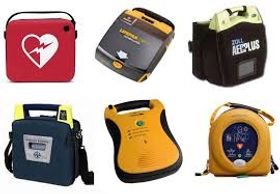CPR & AED In action
A 3D view of CPR
CPR & AED in action
Automatic External Defibrillation
Free to access information
Citizen Aid
Public Access Defibrillators

The citizenAID Pocket Guide is a clear and simple series of immediate actions. YOU can be the person to provide information to the emergency services, to help organise others at the scene and to give life-saving care while waiting for the professionals to arrive.
Public Access Defibrillators
Public Access Defibrillators

Public Access Defibrillators (PAD or CPAD) are Automatic External Defibrillators (AED) provided for use by the public. No training is required to use these safe devices as they instruct the user during the process. Generally accessible from a secure cabinet by contacting the emergency services.
First Aid for Heart Attacks
Cerebral Vascular Incidents (Strokes & TIA's)

What are the signs & symptoms of a Heart Attack? What is the treatment? Click Find Out More to discover.
Cerebral Vascular Incidents (Strokes & TIA's)
Cerebral Vascular Incidents (Strokes & TIA's)

A Stroke is a serious medical condition that occurs when the blood supply to part of the brain is cut off. Strokes are a medical emergency and prompt treatment is essential because the sooner a casualty receives treatment for a stroke, the less damage is likely to happen to them. If you suspect a stroke act FAST and call 999/112 for the emergency services.
- Facial weakness,
- Arm weakness,
- Speech problems,
- Time to call 999
Unconscious Casualty

The ten most common causes of Unconsciousness can be remembered by the acronym FISHSHAPED.
- Faint
- Imbalance of Temperature
- Shock
- Head Injuries
- Stroke
- Heart Attack
- Asphyxia
- Poisons
- Epilepsy
- Diabetes
The Effects of Temperature

Effects of High & Low Body Temperature
The human body is normally considered to have a core temperature lying within the range of 36.5-37.5°C. It takes a surprisingly small deviation from that mean temperature to have a significant effect on our welfare. The following information is a guideline to typical range and effect.
· 44°C or more – Almost certainly death will occur; however, people have been known to survive up to 46.5 °C.
· 43°C – Normally death, or there may be serious brain damage, continuous convulsions and shock. Cardio-respiratory collapse will likely occur.
· 42°C – Subject may turn pale or remain flushed and red. They may become comatose, be in severe delirium, vomiting, and convulsions can occur. Blood pressure may be high or low and heart rate will be very fast.
· 41°C – (Medical emergency) – Fainting, vomiting, severe headache, dizziness, confusion, hallucinations, delirium and drowsiness can occur. There may also be palpitations and breathlessness.
· 40°C – Fainting, dehydration, weakness, vomiting, headache, breathlessness and dizziness may occur as well as profuse sweating. Starts to be life-threatening.
· 39°C – Severe sweating, flushed and red. Fast heart rate and breathlessness. There may be exhaustion accompanying this. Children and people with epilepsy may be very likely to get convulsions at this point.
· 38°C – (Classed as hyperthermia if not caused by a fever) – Feeling hot, sweating, feeling thirsty, feeling very uncomfortable, slightly hungry. If this is caused by fever, there may also be chills.
· 36.5–37.5 °C is a typically reported range for normal body temperature.
· 36°C – Feeling cold, mild to moderate shivering. Body temperature may drop this low during sleep. May be a normal body temperature.
· 35°C – (Hypothermia is less than 35 °C) – Intense shivering, numbness and cyanosis of the skin. There is the possibility of heart irritability.
· 34°C – Severe shivering, loss of movement of fingers, blueness and confusion. Some behavioural changes may take place.
· 33°C – Moderate to severe confusion, sleepiness, depressed reflexes, progressive loss of shivering, slow heartbeat, shallow breathing. Shivering may stop. Subject may be unresponsive to certain stimuli.
· 32°C – (Medical emergency) – Hallucinations, delirium, complete confusion, extreme sleepiness that is progressively becoming comatose. Shivering is absent (subject may even think they are hot). Reflex may be absent or very slight.
· 31°C – Comatose, very rarely conscious. No or slight reflexes. Very shallow breathing and slow heart rate. Possibility of serious heart rhythm problems.
· 28°C – Severe heart rhythm disturbances are likely and breathing may stop at any time. Patient may appear to be dead.
24-26°C or less – Death usually occurs due to irregular heart beat or respiratory arrest; however, some patients have been known to survive with body temperatures as low as 14.2°C.